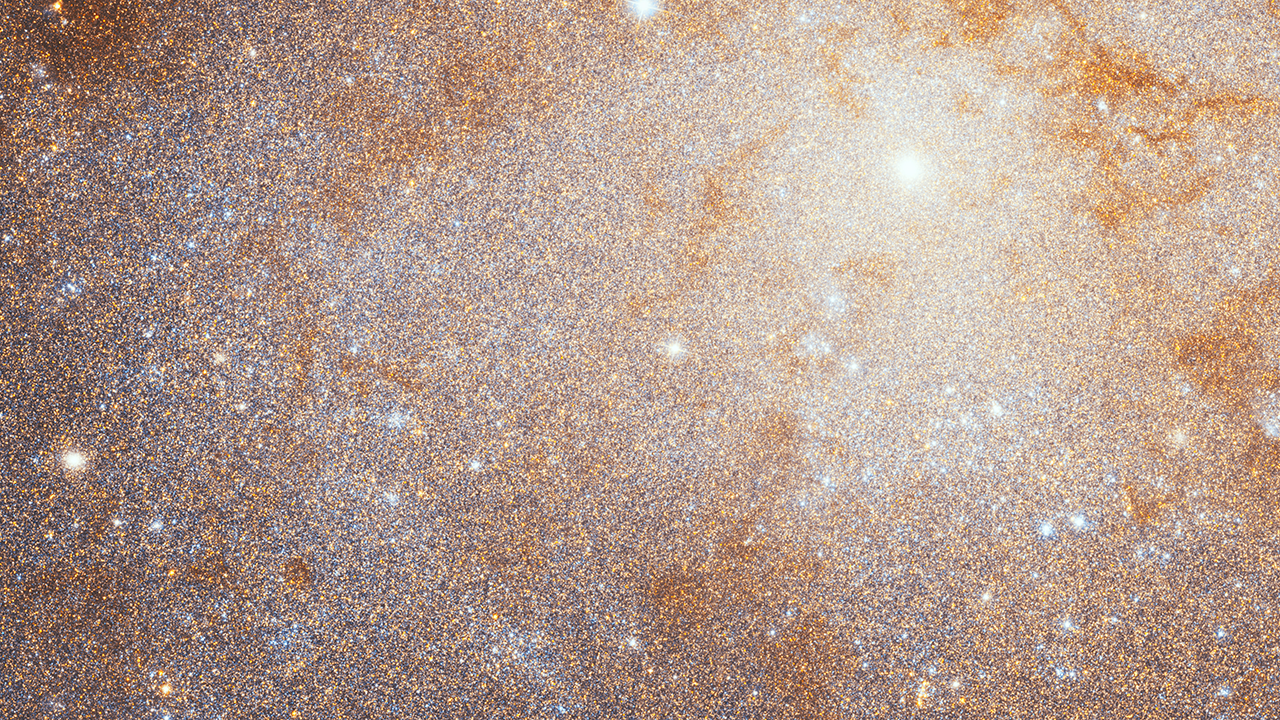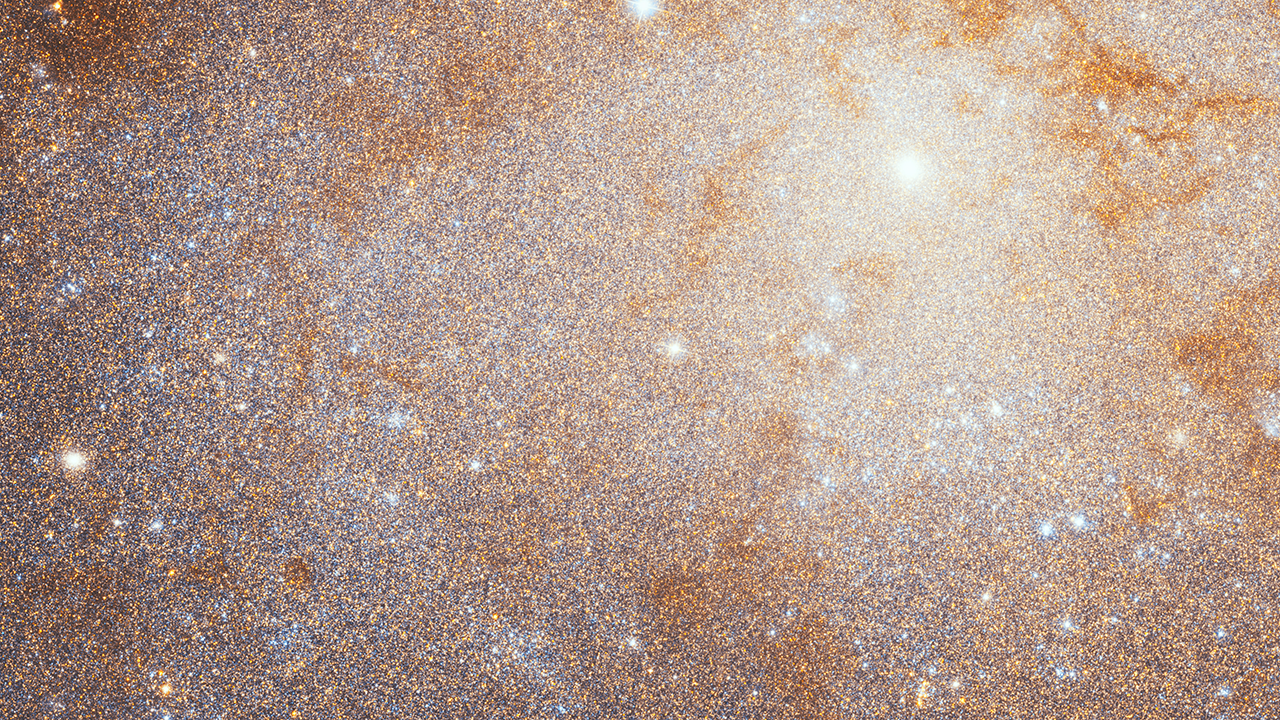1 min read
Triangulum Galaxy Messier 33 (M33)

Triangulum Galaxy Shows Stunning Face in Detailed Hubble Portrait
NASA's Hubble Space Telescope brings the vastness of space into perspective in this mosaic image of the Triangulum galaxy (M33), our neighbor in a collection of dozens of galaxies called the Local Group.
The unprecedentedly detailed portrait of Triangulum is composed of 54 Hubble fields of view stitched together, revealing nearly 25 million individually resolved stars. The borders of individual Hubble images trace the jagged edge of the mosaic, which spans 19,400 light-years across. Striking areas of star birth glow bright blue throughout the galaxy, particularly in beautiful nebulas of hot, ionized hydrogen gas like star-forming region NGC 604 in the upper left.
Triangulum is oriented with its face toward us, ideal for studying the distribution of stars and gas in its well-defined spiral structure. While astronomers are still delving into the immense trove of data collected by Hubble, a few characteristics stand out immediately, inviting key comparisons and contrasts with our own Milky Way galaxy and the third large spiral in the Local Group, the Andromeda galaxy.
"My first impression on seeing the Hubble images was, wow, that really is a lot of star formation," said astronomer Julianne Dalcanton of the University of Washington in Seattle, who led the project. "The star formation rate intensity is 10 times higher than the area surveyed in the Andromeda galaxy in 2015 (http://hubblesite.org/news_release/news/2015-02)."
Astronomers think that Triangulum has been an introvert, avoiding disruptive interactions with other galaxies, instead spending the eons tending its well-ordered spiral and turning out new generations of stars. Further research may determine if Triangulum is actually a newer member of the Local Group of galaxies, and perhaps its quiet days will soon be over.
This mosaic was created from images taken by Hubble's Advanced Camera for Surveys between February 2017 and February 2018.
The Hubble Space Telescope is a project of international cooperation between NASA and ESA (European Space Agency). NASA's Goddard Space Flight Center in Greenbelt, Maryland, manages the telescope. The Space Telescope Science Institute (STScI) in Baltimore, Maryland, conducts Hubble science operations. STScI is operated for NASA by the Association of Universities for Research in Astronomy in Washington, D.C.
About the Object
- R.A. PositionR.A. PositionRight ascension – analogous to longitude – is one component of an object's position.01:34:33.5
- Dec. PositionDec. PositionDeclination – analogous to latitude – is one component of an object's position.+30:47:58.48
- ConstellationConstellationOne of 88 recognized regions of the celestial sphere in which the object appears.Triangulum
- DistanceDistanceThe physical distance from Earth to the astronomical object. Distances within our solar system are usually measured in Astronomical Units (AU). Distances between stars are usually measured in light-years. Interstellar distances can also be measured in parsecs.2.73 million light-years
- DimensionsDimensionsThe physical size of the object or the apparent angle it subtends on the sky.Full Mosaic Image is about 14.9' by 24.5' (11,600 by 19,400 light-years)
About the Data
- Data DescriptionData DescriptionProposal: A description of the observations, their scientific justification, and the links to the data available in the science archive.
Science Team: The astronomers who planned the observations and analyzed the data. "PI" refers to the Principal Investigator.Hubble data for this release were obtained from HST proposal 14610 (J. Dalcanton) - InstrumentInstrumentThe science instrument used to produce the data.ACS/WFC
- Exposure DatesExposure DatesThe date(s) that the telescope made its observations and the total exposure time.54 observations between Feb 2017 and Feb 2018
- FiltersFiltersThe camera filters that were used in the science observations.F475W, F814W
- Object NameObject NameA name or catalog number that astronomers use to identify an astronomical object.Triangulum Galaxy - M33
- Object DescriptionObject DescriptionThe type of astronomical object.Spiral Galaxy
- Release DateJanuary 7, 2019
- Science ReleaseTriangulum Galaxy Shows Stunning Face in Detailed Hubble Portrait
- Credit

These images are a composite of separate exposures acquired by the ACS instrument on the Hubble Space Telescope. Several filters were used to sample narrow wavelength ranges. The color results from assigning different hues (colors) to each monochromatic (grayscale) image associated with an individual filter. In this case, the assigned colors are: Cyan: F475W Orange: F814W

Related Images & Videos

Triangulum Galaxy (M33) Crop
Hubble Maps an Undisturbed Spiral Galaxy in the Milky Way's Backyard NASA's Hubble Space Telescope has produced its largest mosaic image ever of the Triangulum galaxy (M33). This image spans 14,500 light-years. Triangulum seems to have emerged from the ages having interacted...

Close-up Views of Triangulum Galaxy (M33)
Details in the Triangulum galaxy While the Triangulum galaxy (M33) has led a quiet life compared to other massive galaxies, it still contains evidence of a rich "inner life." This collage zooms into several areas of the larger mosaic, highlighting the amazing details that NASA's...

Zoom into the Triangulum Galaxy – Short Version
Fly across the local galactic neighborhood to the Triangulum galaxy (M33), a smaller spiral than our Milky Way galaxy. Zoom in first on one of M33's bright regions of star birth, nebula NGC 604, glowing with hot ionized hydrogen gas. The remarkable ability of NASA’s Hubble Space...

Zoom into the Triangulum Galaxy – Long Version
Fly across the local galactic neighborhood to the Triangulum galaxy (M33), a smaller spiral than our Milky Way galaxy. Zoom in first on one of M33's bright regions of star birth, nebula NGC 604, glowing with hot ionized hydrogen gas. The remarkable ability of NASA's Hubble Space...
Share
Details
Claire Andreoli
NASA’s Goddard Space Flight Center
Greenbelt, Maryland
claire.andreoli@nasa.gov





























